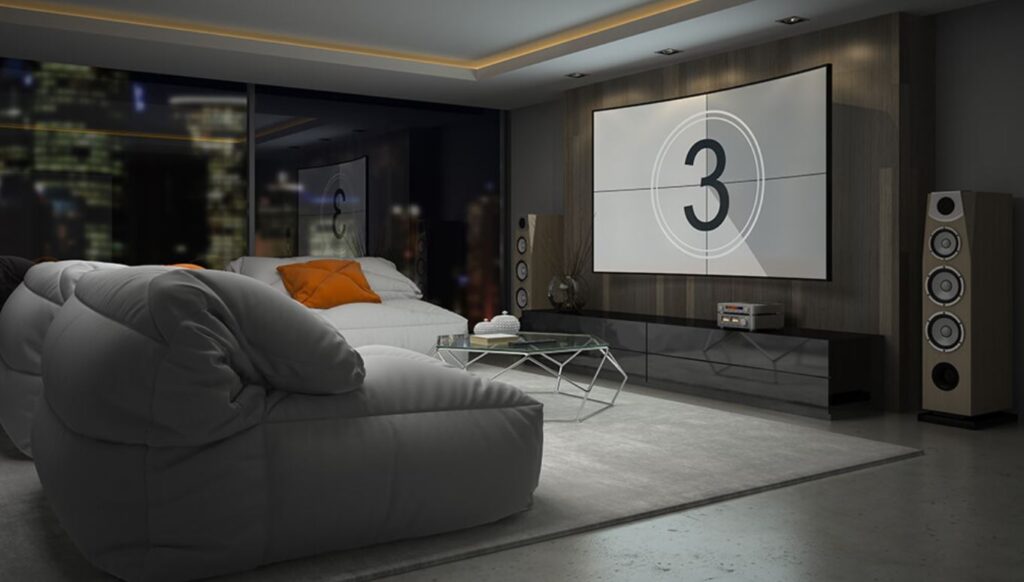Home theaters used to mean dedicated basements and five-figure budgets. Today, the shift is toward transforming everyday living rooms into flexible, high-quality screening spaces.
Rising ticket prices, the convenience of streaming, and the need for filmmakers to review cuts or host private screenings have made this trend explode. For movie lovers, it’s about total control: what to watch, when to watch, and how immersive the setup feels.
Start With the Room: Layout, Throw, and Sightlines
A simple guideline: sit about 1.2–1.6× the screen’s diagonal away from a TV, and 1.0–1.4× for a projector. This creates an enveloping field of view without neck strain.
Projector vs. TV Placement
-
TVs: Place at seated eye height, with the top third of the screen near eye level.
-
Projectors: Account for throw distance, power outlets, and cabling. Ultra-short-throw projectors can sit on a console below the screen, while ceiling-mounted models suit larger rooms.
Light Control & Reflections
Dark walls, blackout curtains, and matte surfaces minimize reflections. Even a dark rug between seats and screen helps reduce visual washout.
The Gear Stack: Good, Better, Best
Displays
-
Good: 65–75″ LED (bright rooms, affordable).
-
Better: 77–83″ OLED (deep blacks, filmmaker favorite).
-
Best: 4K projector with screen (ALR for UST in bright rooms; matte white for dark rooms).
Audio
-
Good: Premium soundbar + subwoofer.
-
Better: 5.1.2 Dolby Atmos system.
-
Best: 7.1.4 setup with AVR and full room correction.
Sources
Streaming devices, UHD Blu-ray players, or NAS/Plex servers keep your library accessible. Add calibration test patterns for accuracy.
Cables & Power
Use certified HDMI cables, protect equipment with surge protectors, and manage cables for safety.
Acoustics That Matter More Than You Think
First-Reflection Treatment
Place acoustic panels or even bookshelves at reflection points on side walls. Rugs reduce floor reflections and echo.
Bass Management
Experiment with subwoofer placement—corners, mid-walls, or “sub crawl” methods. Use your AVR’s room EQ to balance low-end response.
Soundproofing for Apartments
Heavy curtains, door seals, and plush furniture reduce sound leaks. Simple fixes can keep the neighbors happy.
Filmmaker-Focused Upgrades
Color-Critical Viewing
Choose cinema or filmmaker modes, disable motion smoothing, and consider professional calibration for accurate grading reviews.
Monitoring Audio
Nearfield monitors help when reviewing dialogue mixes. Target comfortable but accurate playback levels.
Workflow Essentials
Enable frame rate and dynamic range matching on streaming devices, keep HDMI chains short, and label inputs by purpose (HDR, SDR, etc.).
Seating & Ergonomics
Rows vs. Single Couch
A single couch works fine, but risers for a second row can add the true theater feel. Even an 8-inch platform can improve sightlines.
Viewing Comfort
Keep the screen centered near eye level, and tilt down TVs placed above fireplaces. Choose seating with good back and neck support.
Accessibility & Safety
Ensure enough walking space behind rows and keep cables out of footpaths.
Aesthetics & Atmosphere
Bias Lighting
Neutral LED bias lights behind TVs reduce eye strain and increase perceived contrast. For projectors, keep the ambient light indirect.
Design Themes
Minimalist frames, media shelves, or poster rails personalize the room without adding glare or clutter.
Smart Controls & Automation
One-button “Movie Night” scenes can dim lights, close blinds, and set AVR volume. Smart remotes and apps keep controls unified, while IR/RF blasters help with hidden devices.
Budget Planner & Sample Builds
| Tier | Display | Audio | Sources | Extras | Est. Cost |
|---|---|---|---|---|---|
| Starter | 65″ LED | Soundbar + sub | Streaming device | Bias light, surge strip | $1,200 |
| Enthusiast | 77″ OLED or UST projector | 5.1.2 Atmos + AVR | Streaming + UHD Blu-ray | Acoustic panels, cable raceways | $3,200 |
| Premium/Creator | Long-throw 4K projector + 120″ screen | 7.1.4 Atmos + room EQ | Streamer + UHD + NAS | Calibration, risers, isolation | $7,500+ |
Common Mistakes to Avoid
-
Sitting too far from the screen.
-
Center speaker aimed at knees instead of ears.
-
Leaving motion smoothing and vivid HDR modes on.
-
All-hard surfaces with no acoustic treatment.
-
Using cheap, long HDMI cables that fail at 4K/8K.
Mini Case Studies
Indie Director in a 1-Bedroom
77″ OLED, 5.1.2 setup, and four wall panels create a color-accurate, compact studio for reviewing cuts.
Family Room Hybrid
UST projector + 100″ ALR screen, with discreet in-wall speakers and hidden subs, transforms from daytime living space to night-time cinema.
Rental-Friendly Setup
75″ LED with a high-end soundbar, removable panels, and cord covers—no drilling required.
Quick Setup Checklist
-
Decide: OLED vs. projector based on room light.
-
Place seats at 1.2–1.6× screen diagonal distance.
-
Run subwoofer calibration and test placements.
-
Treat first reflection points with panels or rugs.
-
Switch to “Cinema” or “Filmmaker” modes.
-
Use certified HDMI and surge protection.
-
Add neutral bias lighting.
-
Keep a simple smart control for lights and volume.
FAQs
Projector or TV for Bright Rooms?
Bright spaces benefit from OLED/LED TVs or UST projectors with ALR screens. Long-throw projectors shine in darker environments.
Is Dolby Atmos Worth It in Small Spaces?
Yes—adding even two height channels (5.1.2) greatly improves immersion.
Do I Need Professional Calibration?
Not mandatory, but it’s the fastest way to get reference-level accuracy. For casual users, using filmmaker presets works well.

